In 2011, for the first time in the Open Era, no male tennis player reached his first Grand Slam semifinal. In 2012 it happened for the second time. This means there hasn’t been a new face in the final four at a Major since the French Open in 2010, when both Tomas Berdych and Jurgen Melzer managed it. It goes without saying that this is the longest such gap in many decades. On the other hand, this year each of the Majors boasted a different winner – Novak Djokovic, Rafael Nadal, Roger Federer and Andy Murray – which is the first time this has happened since 2003. You may curb your wonderment by recalling that these four men also comprised all the finalists. The Big Four, and despite our best marketing efforts this term retains an Orwellian whiff, have hardly become less dominant. Like all tyrants, they’ll never tire of tyranny, but at least they’ve grown a little more open to sharing amongst themselves.
At the Masters level a minor revolution occurred only in the last week of the regular season, when David Ferrer defeated Jerzy Janowicz for the championship in Bercy. It was the first time a player ranked beyond the top four had claimed so august a title in precisely two years. Again, belay your astonishment. Now, as then, it was won by a world No.5 destined soon to rise higher. Indian Wells also had a maiden finalist in John Isner, but this led to nothing. The remaining eight Masters events were won by Federer (3), Djokovic (3) and Nadal (2). Meanwhile the last four at the Tour Finals included Djokovic, Federer and Murray, in addition to previous finalist Juan Martin del Potro, currently ranked No.7. There is no clear end to the repression.
Nadal of course hasn’t played a competitive match since the second round at Wimbledon, and one can be forgiven for assuming this would impact upon the Big Four’s capacity to hoard most of the points. Each of the top four often maintains a stranglehold on his respective quarter of any tournament draw. They don’t necessarily fill out the semifinals at every significant event, but they do manage it far more than at any other time in the sport’s history. Nadal’s withdrawal therefore left a fourth player with an opening. Initially this meant that Andy Murray percolated upwards to assume the third seeding, with Ferrer taking the fourth. 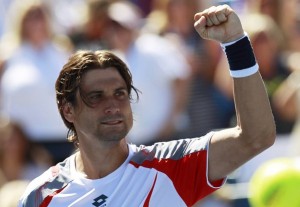 After the US Open, at which Murray was triumphant, Nadal’s ranking slipped to No.4, and Ferrer now took over his compatriot’s seeding directly.
After the US Open, at which Murray was triumphant, Nadal’s ranking slipped to No.4, and Ferrer now took over his compatriot’s seeding directly.
Interestingly enough, this has had only a marginal effect on the top four’s relative dominance, despite Ferrer having his finest season yet. As a group, the top four accrued only slightly fewer points than they had in 2011, which was the most dominant season by so few elite players in history.
The following graph shows the top four’s current aggregate points across all mandatory events (33,180) as a percentage of their maximum possible points (42,740 – derived from all four making at least the semifinals at every event). This is compared to the same data going back to 2000, when the current Masters format was introduced. It gives a useful measure of elite dominance.
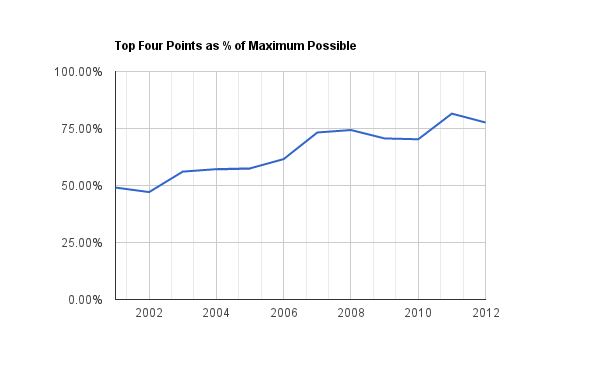 This data excludes the Olympic Games, largely for the sake of convenience, and because the points awarded to the medallists has not been consistent over the years. In any case, including the Games would not materially alter the results: by factoring in the Olympics, this year the top four claimed 77.78% of available points, compared to 77.63% without them.
This data excludes the Olympic Games, largely for the sake of convenience, and because the points awarded to the medallists has not been consistent over the years. In any case, including the Games would not materially alter the results: by factoring in the Olympics, this year the top four claimed 77.78% of available points, compared to 77.63% without them.
There was a slight dip from last year, but it’s difficult to see that Nadal’s absence was the sole reason for it. Even healthy, it is unlikely he would have played either Canada or Bercy, and he traditionally hasn’t performed strongly in Shanghai, Cincinnati or at the tour finals (especially with Spain contesting the Davis Cup final soon afterwards). The US Open is where the most points were conceded – Nadal reached the final in 2010 and 2011 – and they were lost to Ferrer, who reached the semifinal. Then again, Madrid was also a significant factor, even though Nadal was playing. Federer was the only player from the top four to reach the semifinals in the Magic Box. In any case, the upshot is that 2012 was the second most dominant season for the top four, despite Nadal missing half of it.
The main impact of Nadal’s absence has been on his own ranking. He remains at No.4, but only barely: he is just 185 points ahead of Ferrer, and if he fails to reach the Australian Open final next month he will very likely tumble out of the top four for the first time in nearly eight years, even if Ferrer doesn’t turn up. 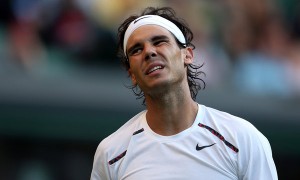 Given that turning up is one of the aspects of the sport at which Ferrer excels, and that Nadal hasn’t contested a competitive match in six months, the likelihood of Nadal falling to No.5 is strong.
Given that turning up is one of the aspects of the sport at which Ferrer excels, and that Nadal hasn’t contested a competitive match in six months, the likelihood of Nadal falling to No.5 is strong.
Also interesting from the above graph is the lack of change from 2003 to 2005, despite the seismic upheaval to the top of the men’s game wrought first by the ascension of Federer in 2004, then of Nadal a year later. The explanation is that in 2003 the points were spread evenly across the top four (Roddick, Ferrero, Federer and Agassi), while the following year, the first of Federer’s dominance, saw a far greater concentration at the top. This continued in 2005, when Nadal commenced his 160 week stint at No.2, and took most of his points from the Nos 3 and 4 (Roddick and Hewitt). But for all three years the aggregate points concentrated within the top four saw only a minor rise.
Indeed, by using the same data we can see precisely how dominant the No.1 has been in a given year. The following graph shows the year-end No.1’s points as a percentage of his maximum total points across all ‘mandatory’ events. This therefore shows how close the No.1 came to having a ‘perfect’ year.
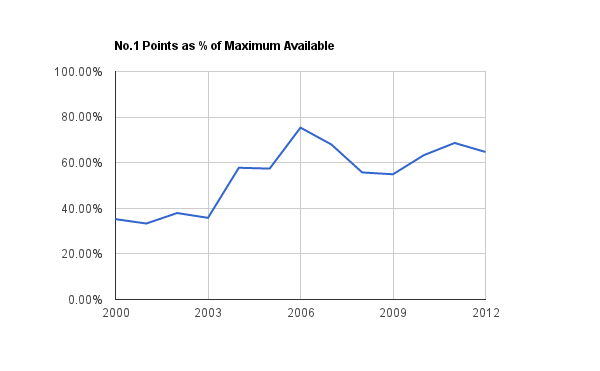 This usefully demonstrates the sudden leap in 2004, but also reveals that this level of dominance has continued since, despite the increasing competition among the top three or four. For comparison’s sake, we would have to go back to 1994-1995, which were the early years of Pete Sampras’ reign, to find a commensurately dominant No.1. (However, given the more haphazard manner in which points were awarded back then the comparison is somewhat spurious.)
This usefully demonstrates the sudden leap in 2004, but also reveals that this level of dominance has continued since, despite the increasing competition among the top three or four. For comparison’s sake, we would have to go back to 1994-1995, which were the early years of Pete Sampras’ reign, to find a commensurately dominant No.1. (However, given the more haphazard manner in which points were awarded back then the comparison is somewhat spurious.) 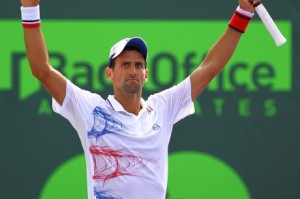 It also demonstrates that Federer’s 2006 is the most dominant year for a single player, at least given the metrics used here: that year he claimed over 75% of the total points he could have claimed at the biggest events.
It also demonstrates that Federer’s 2006 is the most dominant year for a single player, at least given the metrics used here: that year he claimed over 75% of the total points he could have claimed at the biggest events.
This graph also shows us that Djokovic has been slightly less imposing this year than in 2011, which I’m pretty sure we already knew, and should be obvious from the fact that he spent almost half the season at No.2. The surprise, however, is that overall he hasn’t been that much less dominant, which somewhat flies in the face of common wisdom, and indeed seems almost counter-intuitive given the year Federer had. After all, last year Djokovic won three Majors and five Masters events. This year he only won one and three respectively. How can the numbers be so close? The explanation is that by reaching the final of Roland Garros, by winning the World Tour Finals undefeated and by performing strongly elsewhere, the world No.1 mostly off-set those other tournaments at which he failed to replicate last year’s total mastery. He has put together one of the finest seasons in history, and he has managed to do it while winning ‘only’ one Major. The top four have shared plunder more equally than ever before, but Djokovic, once again, has proved that some players are just a little more equal than others.

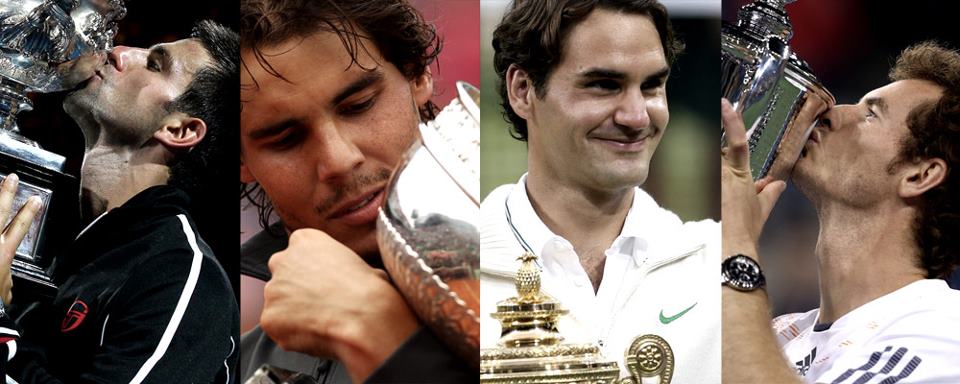
9 Responses to Not A Means, But An End